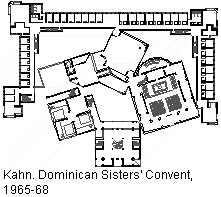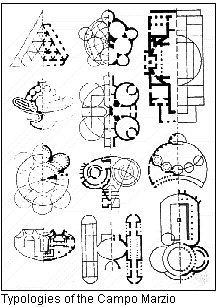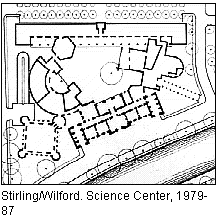Fathoming the Unfathomable
Stephen Lauf
1998.07.08
fathom b : intellectual grasp, penetration, or profundity : COMPREHENSION
unfathomable : not capable of being fathomed a : INCOMPREHENSIBLE, INSCRUTIBLE [all that is cryptic and unfathomable in humanity --J.L.Lowes] b : IMMEASURABLE, IMPENETRABLE
intrigue 3 : the plot of a literary or dramatic work esp. marked by an intricacy of design or action or a complex interrelation of events
Giovanni Battista Piranesi's Ichnographia Campus Martius is unquestionably a plan full of intrigue. The depth of its detail is equally matched by the depth of its meaning. To understand this plan requires total immersion, even though every aspect of the plan is already completely open to view. Therein lies the Ichnographia's greatest irony -- all the pieces are visibly in place while the overall effect remains a puzzle.
The Encyclopedia Ichnographica is the result, so far, of over a decade's worth of re-drawing and re-search, with the joint goal of both efforts being to lift the Ichnographia's shroud of puzzlement, as well as to finally place Piranesi's plan among architecture's paramount designs. Working with the Ichnographia is still rarely easy, however; the Latin labels throughout the plan do not always translate well, Piranesi's archeological inaccuracies are enduring hurdles, and the ongoing reading of both ancient and modern texts, along with reading and re-drawing the hundreds of plans within the large plan, is continually intense. Nevertheless, the Ichnographia rewards splendidly because, after the removal of many layers of incomprehensibility, Piranesi's large plan delivers numerous double narratives where inversion, if not satire, is the dominant theme. In more concise terms, the Ichnographia comes to represent Piranesi's delineation of ancient Rome's story from beginning to end.
After so many years of being intimately involved with the Ichnographia Campus Martius, it is slightly disconcerting to not know exactly when I first saw the large plan. If memory serves me correctly, my initial knowledge of Piranesi's Campo Marzio plan came with the anecdote of how a copy of the plan hung over Louis I. Kahn's office desk. Even though I now know that Vincent Scully relates this information within his book, Louis I. Kahn, I believe the account of the Ichnographia hanging over Kahn's desk is something I originally heard in architecture school rather than read, and, since many of the mid-1970s faculty members at Temple University's Department of Architecture were either students of Kahn or had worked in Kahn's office, my assumption is reasonably sound.
Almost as a matter of course, the early years of my architectural education produced a strong personal interest in Kahn's geometric planning, specifically Kahn's unique ability of turning rigorous combinations of simple shapes into elegant plan compositions. Piecing things together, it then seemed obvious that Piranesi's plan of the Campo Marzio was a source of inspiration for Kahn's planning principles. Therefore, if I was to learn how to design like Kahn, I too needed Piranesi's plan for inspiration.
 
The Ichnographia remained elusive, however. My search through books and journals yielded reproductions of only portions of the plan, or reduced reproductions of the entire plan were near the point of illegibility. Over several years, I was still not able to compile a readable image of the Ichnographia, nevertheless, other factors began to broadened my comprehension of the plan. A group of diagrams labeled Typologies of the Campo Marzio, which appeared in the Summer 1978 edition of Oppositions 13, indicated that an investigation of Piranesi's plans had already occurred, yet the article [George Teyssot (Christian Hubert, trans.), "Emil Kaufmann and the Architecture of Reason: Klassizismus and 'Revolutionary Architecture'" in Oppositions 13 (Cambridge, MA: The MIT Press, Summer, 1978).] that included the 'typologies' offered no explanation of the analysis behind the diagrams. Even so, the diagrams present a clear message regarding a congruous geometry underlying the Ichnographia's individual plans. This finding registered a shift in my overall interest of the large plan so that, rather than wanting to learn about what inspired Louis Kahn's method of designing buildings and drawing plans, I became much more inquisitive as to what inspired Piranesi's distinctive ichnographic method.
The other factor that shifted my interest in Piranesi's Campo Marzio was a Stirling/Wilford building from 1979, which manifestly combined the ideas of typology and collage into a single coherent architectural design, the Wissenschaftszentrum (Science Center), Berlin. This Stirling/Wilford design is certainly a "spin-off" of Kahn's Convent for the Dominican Sisters, yet the Berlin building also clearly introduces a new motif within late 20th century architecture, namely the notion that formal abstraction can also include tectonic shapes that possess distinct architectural and typological associations. Of course, this methodology does not come without irony because the associations rendered through the Science Center design in no way relate to the building's functional program, yet the use of recognizable and comprehensible forms within a building's design still adds a potent element whereby modern architecture is able to deliver a readable message. I saw Stirling/Wilford's new approach as a further extension of the inspiration Kahn initially derived from Piranesi, and my supposition was reinforced by Charles Jencks who, as guest-editor of Architectural Design's 'Post-Modern Classicism,' [Charles Jencks, guest editor, "Post-Modern Classicism -- The New Synthesis," Architectural Design, vol. 50, no. 5/6, 1980, p. 75.] without explanation placed Piranesi's aerial perspective of the Campo Marzio next to a top view photograph of a model of the Science Center.
 
My formal architectural education thus ended in May 1981 with my designing an Institute of Contemporary Art where I explored typology and collage, and, judging from the design's schematic sketches, Piranesi influenced me more than I probably cared to admit at the time. Furthermore, as fate would have it, within weeks of my graduation I found a poster of the Ichnographia in the AIA Philadelphia Bookstore. I immediately purchased the poster, and promptly hung it over my drafting table at home.
| |
Encyclopedia Ichnographica
1999.11.07 20:43
As it stands now, my ongoing investigation and redrawing of the Ichnographia has led to the 'discovery' of a whole new aspect of Piranesi's work that so far no one else has found, namely that the large plan of the Campo Marzio is a readable narrative of Ancient Rome's political and architectural history--but in order to grasp this delineated 'text' one must 'read' in unison the individual plans, the plans in relationship to each other, the plans in relation to where the actual buildings really were, and (this is perhaps the most important) the Latin labels Piranesi gives to each plan.
cf. reinterpretation
...and Piranesi
2005.04.17 14:47
Piranesi did a whole lot more than visually represent "improbable and imagined" spaces. Piranesi was primarily an ur-archaeologist, and his hands-on understanding of "history" manifests an unprecedented delineation of how history coalesces with (architectural) design. Even Piranesi's personal design history manifests a coalescence, e.g., Prima Parti di Architetture e Prospettive through the Carceri through the Osservazioni sopra la Lettre de M. Mariette through the Diverse Maniere d'Adornare i Cammini through the Vasi, Candelabri, Cippi.
...remember when you responded with:
"Xavier Costa, in a class he taught at the AA while I was there, related it [the Ichnographia Campi Martii] to museological strategies/memory aids. Not sure that this is what you are asking, and I don't know if he ever published such a thing."
Could it be that Costa received his information from Marcel Baumgartner's "Topographie als Medium der Erinnerung in Piranesi's 'Campo Marzio dell' Antica Roma'"? published in 2000? Baumgartner at least admits/footnotes his knowledge of the Encyclopedia Ichnographica as published at www.quondam.com from 1 July 1998 to 20 March 2000.
Eisenman was rocked in his socks!
2005.11.15 13:17
[Eisenman] mentions in "The Wicked Critic" (2000) that "This document [the Ichnographia], then, is a useful example for Tafuri for two principal reasons: first, in his montage of actual buildings, fantasy buildings, and buildings moved from their actual site..." It's worthwhile noting that no where does Tafuri ever mention that some buildings within the Ichnographia are moved from their actual site, yet within the Encyclopedia Ichnographica as published at www.quondam.com 1998-2000 there is much note of buildings within the Ichnographia that Piranesi moved from their actual site. Moreover, that Piranesi moved some buildings from their actual site is indeed part of the original material within the analysis of the Ichnographia at www.quondam.com.
|



